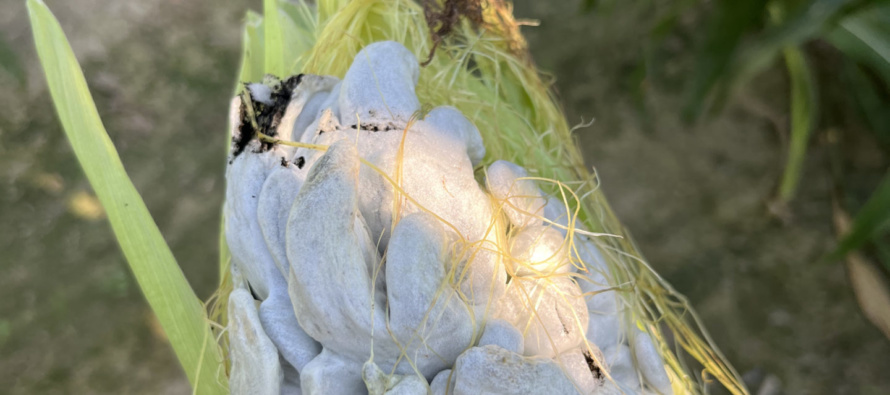Corn Disease Update: Week Ending July 16, 2022

Related Articles
- 2010 Soybean And Corn Variety Trial Data 3
- Rice Variety Trial Results For 2010, Plus Rice Research Report 0
- Evaluation of Peanut Prescription Rx Program in Mississippi 0
Latest Tweets
The 2022 season has been relativey quiet when it comes to plant disease issues impacting the corn crop. Many of our more common diseases (e.g., common rust, NCLB) have been barely present to this point in the season. In fact, I think I have only seen a handful of NCLB lesions myself and only received one telephone call related to the presence of NCLB. As I am sure I have said numerous times in the past, hot and dry conditions are generally not conducive for most foliar fungal disease-causing organisms.

Physoderma brown spot. Note the different lesion types between leaf material as well as the midrib and the leaves wrapped around the stalk.
Physoderma brown spot
A relatively new disease for most looking at corn over the past several seasons. Lesions can be observed up and down the leaves wrapped around the main stem and on leaves themselves. However, the lesions on leaves and along the midrib will appear different from one another. The yellow discoloration on leaves greatly differs from the presence of the chocolate brown lesions that can form along the midrib on the leaf as well as on the leaves wrapped around the stalk. Pinpoint lesions occur along the leaves in a banding “pattern” that can cover a substantial part of the leaf on infected plants. The chocolate brown lesions on the midrib can cover the bulk of the midrib while the lesions against the stalk on leaves are generally in small groups. Typically, when Physoderma is observed it can be a small clump of plants or several plants in a row depending on previous crop (continuous corn has been observed to contain more infected plants).
Management of Physoderma brown spot once the disease is observed is not warranted. The infection by the fungus likely occurred much earlier in the season. I suspect that some of the weather that we received shortly after planting this year, which tended to be rather wet depending on geography within MS greatly contributed to the amount of Physoderma brown spot this year. In addition, the disease can be rather “showy” depending on how many plants are observed in a given field.
Even though Physoderma has been reported to result in a stalk rot, I have not observed the stalk rot in MS in the time that I’ve been employed by MSU.
Corn smut
I have received numerous calls this season related to corn smut. Corn smut has most definitely been more commonly observed this year than in the past. I think a lot of that can be attributed to the high winds and some of the other weather situations we have encountered. Anything that leads to damage/injury of the corn plant can open a wound court for the smut fungus to enter and produce the grey fruiting galls. The galls begin as a white to grey translucent mass and once mature will open and release the black-colored smut spores. The galls containing spores drop to the soil and are incorporated at tillage. The fungus can then reinfect in the future when conditions are right and when corn is grown in that field.
Infection from the smut fungus occurs at points on the corn plant that have been wounded or injured. Injury that occurs in the form of: Wind damage or breakage, bird feeding, insect feeding, or even hail damage can open a wound and allow the fungus to infect the plant. The smut fungus can infect any part of the corn plant. However, we most commonly observe smut on the ears or where the tip of the ear may have been damaged. Smut galls that form on leaves do not generally produce spores and the galls will more often resemble a wart on the leaf tissue where injury and subsequent infection has occurred. Once smut is observed in the field no management practices are necessary. The best form of management would be in the form of deep tillage and rotation out of corn for several years in situations where the fungus appears to have been yield-limiting. Yield reductions, or large yield reductions associated with smut are rare.
Southern rust
Until Saturday July 9, 2022 I had not observed the first pustules of southern rust. Several states have previously reported southern rust in the southern U.S., with the greatest concentration of counties with infected plant material being in Georgia, far to our east. However, since 7/9/2022, I have had several conversations with farmers, consultants, and retailers that have observed extremely low levels of southern rust, and MS now contains four counties (Coahoma, Noxubee, Sunflower, and Washington counties as of 7/16/22 10 am) with active southern rust. Given the general growth stage of the bulk of our corn, I do not think that southern rust will be much of an issue at this time. However, the rainfall that generally moves southern rust inoculum throughout much of MS has not been near as plentiful this year.
To stay abreast of the situation in the southern U.S. and more specifically in MS, please visit https://corn.ipmpipe.org/southerncornrust/ for the current situation. I tend to update the map as I find southern rust throughout the state and given that the disease has recently been observed it is likely that numerous additional counties contain infected corn. Scout carefully and base fungicide application decisions for southern rust on the general growth stage of the corn and the overall yield potential.





Let me tell You a sad story ! There are no comments yet, but You can be first one to comment this article.
Write a comment